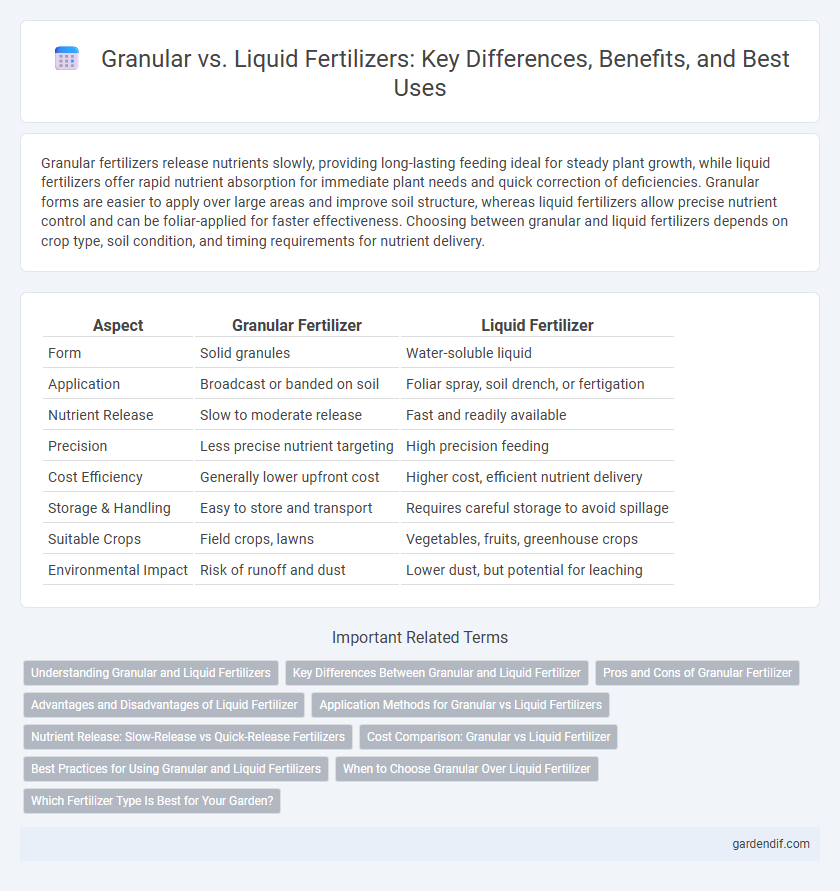
Granular vs Liquid Illustration
Granular fertilizers release nutrients slowly, providing long-lasting feeding ideal for steady plant growth, while liquid fertilizers offer rapid nutrient absorption for immediate plant needs and quick correction of deficiencies. Granular forms are easier to apply over large areas and improve soil structure, whereas liquid fertilizers allow precise nutrient control and can be foliar-applied for faster effectiveness. Choosing between granular and liquid fertilizers depends on crop type, soil condition, and timing requirements for nutrient delivery.
Table of Comparison
| Aspect | Granular Fertilizer | Liquid Fertilizer |
|---|---|---|
| Form | Solid granules | Water-soluble liquid |
| Application | Broadcast or banded on soil | Foliar spray, soil drench, or fertigation |
| Nutrient Release | Slow to moderate release | Fast and readily available |
| Precision | Less precise nutrient targeting | High precision feeding |
| Cost Efficiency | Generally lower upfront cost | Higher cost, efficient nutrient delivery |
| Storage & Handling | Easy to store and transport | Requires careful storage to avoid spillage |
| Suitable Crops | Field crops, lawns | Vegetables, fruits, greenhouse crops |
| Environmental Impact | Risk of runoff and dust | Lower dust, but potential for leaching |
Understanding Granular and Liquid Fertilizers
Granular fertilizers consist of solid particles that release nutrients gradually into the soil, providing long-lasting feeding for plants. Liquid fertilizers offer immediate nutrient availability by being dissolved in water, allowing for quick absorption through leaves or roots. Selecting between granular and liquid types depends on crop needs, application methods, and timing for optimal nutrient uptake and growth.
Key Differences Between Granular and Liquid Fertilizer
Granular fertilizers release nutrients slowly, improving soil structure and providing long-term nourishment, while liquid fertilizers deliver nutrients quickly, allowing for rapid plant absorption and targeted feeding. Granular types are easier to store and apply over large areas, whereas liquid fertilizers require precise dilution and application methods for effectiveness. The choice between granular and liquid depends on crop needs, soil conditions, and timing of nutrient delivery for optimal growth and yield.
Pros and Cons of Granular Fertilizer
Granular fertilizer offers long-lasting nutrient release and is easier to store and transport compared to liquid options. It provides a slow, steady supply of nutrients, reducing the risk of leaching but may take longer to become available to plants. However, granular fertilizer application can be less precise and may require additional watering to activate nutrients effectively.
Advantages and Disadvantages of Liquid Fertilizer
Liquid fertilizer offers fast nutrient absorption and uniform application, enhancing crop growth efficiency and reducing the risk of nutrient runoff. However, it requires specialized equipment for application and may have higher initial costs compared to granular fertilizers. Storage and handling of liquid fertilizers pose challenges due to their potential for spillage and shorter shelf life.
Application Methods for Granular vs Liquid Fertilizers
Granular fertilizers are typically applied using spreaders or by hand, allowing for slow nutrient release and extended feeding periods. Liquid fertilizers are applied via sprayers or fertigation systems, providing rapid nutrient absorption and precise application. Selecting the appropriate method enhances nutrient availability and supports optimal crop growth.
Nutrient Release: Slow-Release vs Quick-Release Fertilizers
Granular fertilizers typically offer slow-release nutrient delivery, providing plants with a steady nutrient supply over time, which reduces the risk of nutrient leaching and promotes sustained growth. Liquid fertilizers deliver nutrients in a quick-release form, allowing for rapid absorption and immediate nutrient availability, ideal for correcting deficiencies or supporting fast-growing crops. Understanding the nutrient release rates helps optimize fertilization strategies to enhance crop yield and nutrient use efficiency.
Cost Comparison: Granular vs Liquid Fertilizer
Granular fertilizers typically have a lower upfront cost compared to liquid fertilizers, making them a more budget-friendly option for large-scale farming. Liquid fertilizers often require specialized application equipment and repeated applications, increasing overall expenses. Cost efficiency depends on crop type, application frequency, and nutrient delivery precision.
Best Practices for Using Granular and Liquid Fertilizers
Granular fertilizers release nutrients slowly, making them ideal for long-term feeding in soil with stable moisture levels, while liquid fertilizers provide immediate nutrient availability and are best used for foliar feeding or quick nutrient corrections. Applying granular fertilizers before planting ensures steady nutrient uptake, whereas liquid fertilizers are most effective when applied during active growth stages to promptly address nutrient deficiencies. Proper calibration of application rates and timing for both forms maximizes nutrient efficiency, reduces environmental runoff, and promotes optimal crop yield.
When to Choose Granular Over Liquid Fertilizer
Granular fertilizer is ideal for providing long-lasting nutrient release, especially in soil that requires consistent feeding over time. It is preferred when nutrient needs are well-defined and slow absorption is beneficial, such as in established lawns or garden beds. Granular fertilizers also enhance soil structure and reduce the risk of nutrient runoff compared to liquid alternatives.
Which Fertilizer Type Is Best for Your Garden?
Granular fertilizers release nutrients slowly, making them ideal for long-term soil nourishment and sustained plant growth, while liquid fertilizers provide rapid nutrient absorption, perfect for quick boosts and foliar feeding. Granular types are often preferred for vegetable gardens and lawns due to their ease of application and cost-effectiveness, whereas liquid fertilizers excel in container plants and hydroponics where immediate nutrient availability is crucial. Choosing the best fertilizer depends on your garden's specific needs, soil type, and desired nutrient delivery speed.
Granular vs Liquid Infographic

 gardendif.com
gardendif.com